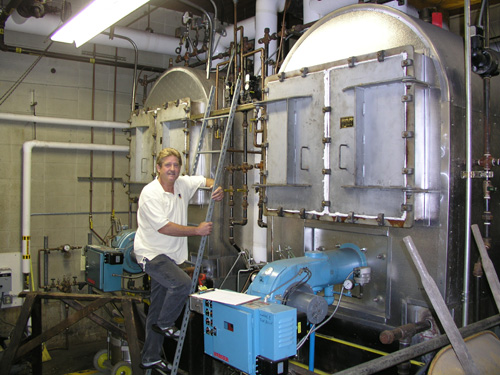Monroe Middle School

Introduction
We performed an in-depth energy audit of Monroe Middle School from May 17 through May 31, 2006. The goals of the audit were to determine if use of heat and lights is consistent with building occupancy, if room temperatures are comfortable, and if the relative humidity is appropriate.
We collected information from:
• Onset HOBO ® data loggers, which record measurements of room temperature, relative humidity, and light intensity.
• Jay Benner, the Head Custodian, and Gary Heldt, the Eugene 4J School District Engineer, who gave us information about the lighting system and controls, the heating system and controls, and whether or not these systems are automated.
• Staff and teachers, who gave us information about their level of comfort in their offices or classrooms.
Temperature
The school is heated by hot water from two low pressure boilers. The boilers were shut down after May 12, except for a few hours on cool mornings, so the temperature measurements from the data loggers show only how the building responds to outdoor temperatures.
The temperature data show that the building easily absorbs and holds heat. When outdoor temperatures were in the mid-70s or higher, classrooms were higher than the thermal comfort zone, according to ASHRAE standards (65°F - 71°F). According to the surveys, the rooms are too warm on hot spring and fall afternoons. Temperatures in the rooms do not cool down overnight--on the hottest days, some room temperatures did not go below 76°F.
The District cannot afford air conditioning, and the controls for ventilation cannot be programmed to bring cooler outdoor air into the rooms in the mornings. The south and west sides of the building have many windows, but the rooms on those sides do not get warmer than rooms on the north and east sides of the building. The interior rooms seem to stay cooler than the rooms on the outer sides of the building.
• Recommendations: Not all rooms have fans. If possible, buy more fans and buy awnings for windows. Awnings are now being made with photovoltaic cells, so the school could generate some of its own electricity.
Air quality
One survey respondent from the A area commented that rooms are often stuffy even if the temperature is right. Fresh air is supplied when the heat is on because the warm air is mixed with outdoor air. If the heat has not come on for awhile, the rooms may become stuffy.
* Recommendation: Find out when this problem occurs. Is it winter only when the outdoor temperature is too cold to open doors and windows? If possible, monitor air quality.
Lighting
Lights have been upgraded, and the use of lights corresponds well to occupancy.
Relative Humidity (RH)
Relative humidity (RH) stayed between 35 and 64%, which is good. According to the American Society of Heating, Refrigerating and Air-Conditioning Engineers (ASHRAE) comfort standards, RH should be between 30 and 60%.
Energy performance rating
The Portfolio Manager rating for Monroe is 63. This is a good score, although it is not high enough to qualify for ENERGY STAR. However, we did not see any obvious ways to decrease energy use with the current system and building design.
Conclusion
School District policy and the efforts of the Head Custodian and District Engineer keep energy use low, given the heating system and building design. The few recommendations in this report would require spending money that the District probably does not have.

Jay Benner in Monroe's boiler room
